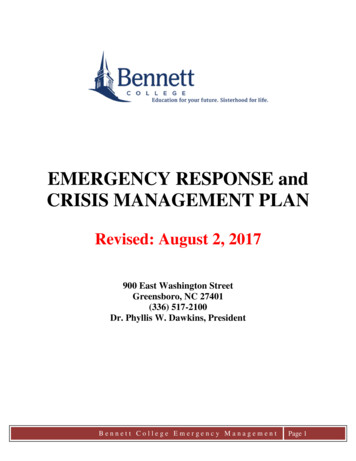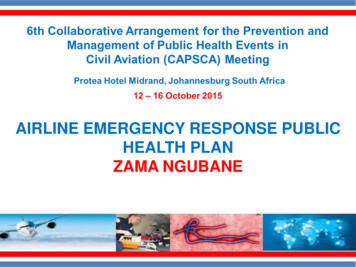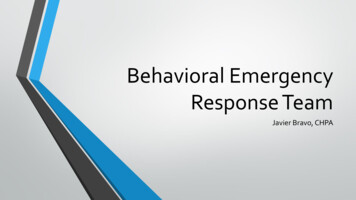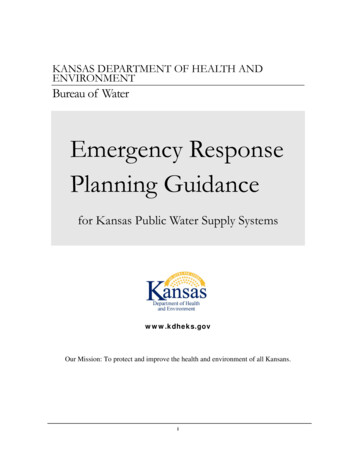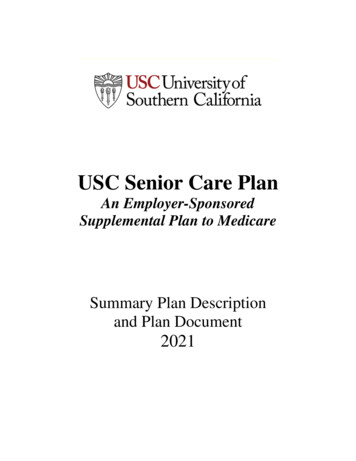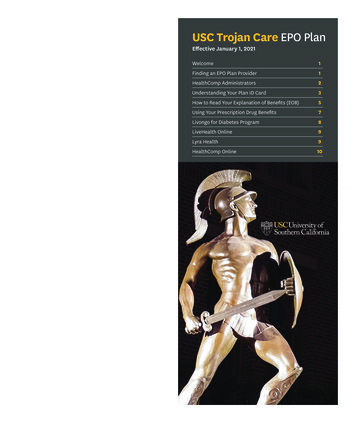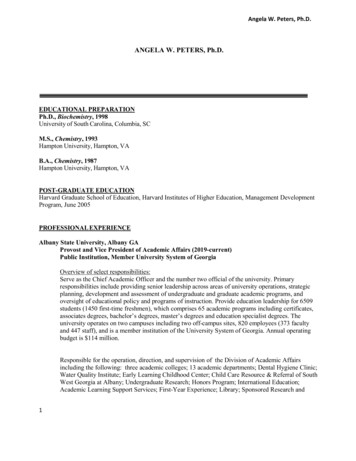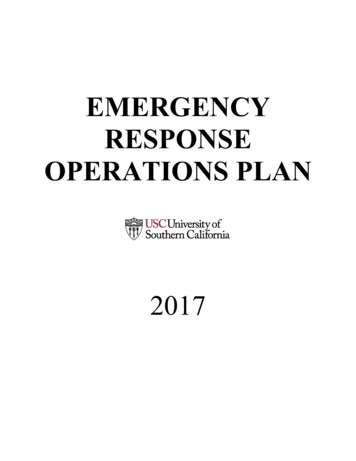
Transcription
EMERGENCYRESPONSEOPERATIONS PLAN2017
USC Emergency Operations PlanCONTENTSUNIVERSITY EMERGENCY RESPONSE PLANPurpose, Scope, Mission & PrioritiesPlan ActivationEmergency Policy GroupEmergency Operations Center (EOC)Emergency Operations GroupDepartment Operations Centers (DOC)Incident Command System (ICS)Incident CommanderUnified Command SystemField Command Post (FCP)Incident Action Plans (IAP)Building Emergency Response Teams (BERT)Campus Emergency Response Team (CERT)Health Sciences Campus (HSC)Business Continuity & Disaster RecoveryTesting and Plan RevisionsEmergency Notification System (TrojansAlert)Emergency Response PrioritiesSuspension of ProgramsCampus EvacuationPlan De-ActivationCrisis Management TeamSpecific Department/ Team RolesUniversity Relations (Communications)11Department of Public Safety (DPS)12Facilities Management Services/Capital Construction Development13Environmental Health & Safety15Fire Safety & Emergency Planning16Student Affairs17Disaster Medical Response Team18Disaster Mental Health Team18Auxiliary Services19-Housing, Hospitality & Transportation133445667788888999910101010112017
USC Emergency Operations PlanInformation Technology Services 20Office of the Provost21Human Resources21Administrative Departments/Academic Schools21Additional Plans21Emergency Response Procedures22Emergency Notification and Telephone Numbers23General Evacuation Procedures24Emergency Roles and Responsibilities25Personal Preparedness27Emergency Response Supplies28Fire29Medical Emergencies31Suspicious Object/Package31Suspicious Person31Bomb Threat Procedures32Chemical Spill or Release33Earthquake34Power Outage35Campus Shooting36Emergency Evacuation for Personswith Disabilities or Access and Functional Needs37Classrooms and Teaching LaboratoriesEmergency Procedures3943AppendicesBuilding Specific Information (Customized)22017
USC Emergency Operations PlanPURPOSE2017The USC Emergency Operations Plan outlines the university’s procedures for managing majoremergencies that may threaten the health and safety of the campus community or disrupt universityoperations. The Plan identifies departments and individuals that are directly responsible foremergency response and critical support services, and it provides a management structure forcoordinating and deploying essential resources.Emergencies both small and large can impact campus operations, academics, research, and patientcare. This plan provides for a framework to ensure incidents are responded to in a coordinatedmanner. Since emergencies and disasters can occur at any time, the university has invested inensuring the university is prepared for and ready to respond to and recover from a major incident.SCOPEThe USC Emergency Plan is an “All-Hazards” plan that allows for flexibility and adaption to theunique needs of every type of emergency and disaster. The university follows the IncidentCommand System to coordinate, communicate and track emergency response actions. This planprovides a framework to ensure efficient communications and coordination between alldivisions, departments and schools responsible for emergency response and recovery. Functionspecific plans including specialized response and recovery plans are developed and maintainedby individual departments, schools, and divisions with support from the Office of Fire Safety &Emergency Planning.EMERGENCY RESPONSE MISSION & PRIORITIESIn any emergency situation, USC’s overriding mission is to:I. Protect life safetyII. Secure critical infrastructure and facilitiesIII. Resume academic, research and patient care servicesPLAN ACTIVATIONSmall scale incidents may occur daily and are responded to and managed by the Department ofPublic Safety, USC Fire Safety, Environmental Health & Safety, Facilities ManagementServices, and other departments depending on the nature of the incident. Small scale incidentsare handled following standard operating procedures developed and maintained within therespective departments. When an incident requires coordination between two or moredepartments, a command post may be established by first responders close to the incident andcoordination will occur in the field utilizing the unified command system (see description). Inthe event of an incident requiring coordination by multiple departments with major impacts tocampus operations, academics, research or patient care, the Department of Public Safety or otherdesignee of Administrative Operations will activate the Emergency Operations Center (EOC).3
USC Emergency Operations Plan2017Public Safety is responsible for providing initial emergency notification to contacts inappropriate emergency service units, who in turn notify their own staff. A full mobilization ofthe emergency response units will then occur, along with full activation of emergency responseteams.EMERGENCY POLICY GROUPResponsibility for overall University direction and internal/external communications in a majoremergency situation rests with the Emergency Policy Group, composed of the President,Provost, Senior Vice President for Administration, Senior Vice President Finance, Senior VicePresident General Counsel, and Senior Vice President University Relations. This group conveneswhen a major emergency occurs, gathers information from emergency response personnel,makes major policy decisions, and coordinates communications with the university, externalstakeholders, and the public.EMERGENCY OPERATIONS CENTERA location where representatives from critical response departments coordinate response andrecovery efforts. The pre-designated locations are: University Park Campus: Tutor Campus Center 232 & 227 (alternate: 3434 Grand Room312) Health Sciences Campus: Keck Hospital Silver Room (alternate: Soto Building TrainingRoom)Activation:The Incident Commander in the field (DPS) will ensure notifications are made to the Chief ofPublic Safety and Administrative Operations senior leadership. If the incident impactsuniversity operations and multiple departments are required to respond, the determinationwill be made to activate the EOC. Partial Activation: Select departments and response teams will be notified to send arepresentative to the EOC location. Communication options include TrojansAlert,Phone, Text Message, Runners, or via two-way radio. Full Activation: All critical response departments and select response teams will benotified to send a representative to the EOC location. Communication optionsinclude TrojansAlert, Phone, Text Message, Runners, or via two-way radio.Emergency Operations Center representatives support responders in the field. The majorfunctions include: Incident Tracking and Tactical Operations Support Logistics and Services Joint Information Center (Communications) Damage Assessment and Repair Tracking and Coordination FinanceThe primary department representatives that make up the EOC Operations Team include:4
USC Emergency Operations Plan2017Department of Public SafetyFacilities Management ServicesCapital Construction DevelopmentEngemann Student Health CenterStudent AffairsEnvironmental Health & SafetyHousingTransportationHospitalityInformation Technology ServicesHuman ResourcesUniversity RelationsOffice of the provostDisaster Mental Health TeamOther departments and specialized teams as requiredWithin the EOC, a senior management team convenes and provides overall strategic direction tothe EOC Operations Team. They also provide information, assessments, and recommendationsto the Policy Group.EMERGENCY OPERATIONS GROUPMembers of the Emergency Operations Center Senior Management Team include:Senior Vice President, Administration Provide liaison with Policy GroupAssociate Senior Vice President,Administrative Operations, or designee(Assisted by Director, Fire Safety/EmergencyPlanning or designee) Provide overall EOC directionProvide direction to hazardous materials and fire responseteamsChief, Public Safety, or designee Manage emergency response operationsDirect DPS resources & coordinate emergencynotificationsCoordinate EOC setupAssociate Senior Vice President, CampusDevelopment & Facilities ManagementServices & Vice President, FacilitiesManagement Manage damage assessment and engineering operationsCoordinate facilities emergency repairsCoordinate facilities recoveryVice President for Auxiliary Services andChief Operating Officer of LA MemorialColiseum and Sports Arena or designee Assist in assessment of Aux. Svcs. FacilitiesCoordinate Housing, Hospitality, and Transportationservices5
USC Emergency Operations Plan2017Associate Senior Vice President, UniversityRelations Gather and provide key information to Policy GroupAssist in disseminating public information andannouncementsVice President, Student Affairs, or designee(Assisted by Executive Director, EngemannStudent Health Center) Coordinate Residential Life responseEnsure that Student Health Center response is initiatedCoordinate assistance measures for studentsCoordinate information for family membersChief Information Officer, InformationTechnology Services, or designee Coordinate technical support to the EOCCoordinate assessment of voice & data networksOffice of the Provost Coordinates response and recovery with all schools andresearch communityUniversity Human Resources Coordinates support to staff and facultyDEPARTMENT OPERATIONS CENTERS (DOC)Each department represented on the Emergency Operations Group and all schools activate aDepartment Operations Center (DOC). The DOC serves as a command post for each departmentwhere they coordinate response efforts. DOC activities include tracking of staff and resources,tracking of incidents and requests for service, and coordination of any specialized functions thatthe department has been designated to manage. Field teams are assigned tasks and are deployedfrom the DOC. Each department maintains a set of equipment to set-up outdoors and customstatus boards and forms to track resources and actions. For a list of DOC coordinators andoutdoor locations, refer to the University Park Campus DOC Critical Response Team List &Map, Academic DOC List & Map, and/or the Health Sciences Campus DOC List and Diagram.INCIDENT COMMAND SYSTEM (ICS)The University of Southern California follows the principles of the National IncidentManagement System (NIMS), which includes the adoption of the Incident Command System(ICS) for emergency response. The Incident Command System is a systematic tool used for thecommand, control, and coordination of emergency response. ICS is based upon a flexible,scalable response organization providing a common framework within which people can worktogether effectively. These people may be drawn from multiple departments that do not routinelywork together, and ICS is designed to give standard response and operation procedures to reducethe problems and potential for miscommunication on such incidents.6
USC Emergency Operations Plan2017The USC Hospital Emergency Command Center follows the State of California HospitalIncident Command System (HICS), which is an incident command system customized for theclinical environment. The system uses all of the same concepts and terminology as regularincident command with the addition of clinical specific divisions and branches.The Campus Emergency Operations Center follows a customized incident command structurethat meets the needs of the university environment.INCIDENT COMMANDERThe person responsible for all aspects of an emergency response; including quickly developingincident objectives, managing all incident operations, application of resources as well asresponsibility for all persons involved. The Incident Commander sets priorities and defines theorganization of the incident response teams and the overall Incident Action Plan. The role ofIncident Commander may be assumed by senior or higher qualified officers upon their arrival oras the situation dictates. The Incident Commander may, at their own discretion, assign Officers,who may be from the same department or from assisting departments, to subordinate or specificpositions for the duration of the Emergency.UNIFIED COMMAND SYSTEMA command structure in which responding departments with responsibility for the incident shareresponsibility and coordinate management of the incident from a single Incident Command Postor EOC. A Unified Command allows university departments with different legal, geographic,and functional authorities and responsibilities to work together effectively without affectingindividual departmental authority, responsibility, or accountability. Under a Unified Command, asingle, coordinated Incident Action Plan will direct all activities.The goals of Unified Command are to: Improve the information flow and interfaces among departments.Develop a single collective approach to the incident regardless of its functional orgeographical complexity.Ensure that all departments with responsibility for the management of the incident havean understanding of their organization’s goals, policies and restrictions.Optimize the efforts of all departments as they perform their respective missions.Reduce or eliminate duplicated efforts.7
USC Emergency Operations PlanFIELD COMMAND POST (CP)2017A central command and control location established by the Incident Commander of an incident ata location that is safe, accessible and large enough to accommodate response staff.Representatives from emergency response departments report to the location to be briefed on theincident and to develop incident action plans for field response teams.INCIDENT ACTION PLANS (IAP)Incident action plans ensure that everyone is working in concert toward the same goals set forthat operational period by providing all incident supervisory personnel with direction for actionsto be taken during the operational period identified in the plan. Incident Action Plans provide acoherent means of communicating the overall incident objectives for both operational andsupport activities. They include measurable strategic objectives to be achieved in a time framecalled an Operational Period.BUILDING EMERGENCY RESPONSE TEAMS (BERT)Every USC owned or operated building has a pre-designated emergency response team identifiedby a yellow vest and hard hat that will spring into action upon notification of an emergency orfire alarm in their building. Team members have been trained to coordinate evacuations, shelterin-place and actions for earthquakes, power outages, medical emergencies, and other hazards.See page 25 of this document for details.CAMPUS EMERGENCY RESPONSE TEAM (CERT)A dedicated team of over 300 staff and faculty throughout the university trained on the 21-hourFEMA course that includes fire suppression, disaster first aid, triage, search & rescue, andincident command. When activated, team members assemble and are dispatched by either FireSafety/Emergency Planning or Public Safety staff.HEALTH SCIENCES CAMPUSThe USC Health Sciences Campus (HSC) will activate an Emergency Operations Center for thecampus in the Keck Medical Center Silver Room. The hospitals and clinical operations willactivate a Hospital Command Center. A unified command concept of operations is used tocoordinate all response and recovery actions. The primary field command post and outdoor DOClocation is the Eastlake side of the Center for Health Professions parking lot. The HSC also hasits own Department Operations Centers, specialized emergency response teams, BuildingEmergency Response Teams, and Community Emergency Response Team. Each departmentmaintains its own customized response and recovery plans that adhere to the National IncidentCommand System.8
USC Emergency Operations Plan2017BUSINESS CONTINUITY & RECOVERY PLANSDisaster recovery/continuity following a disaster at USC is covered in the Disaster Recovery &Business Continuity Plan, a separate document. Individual schools and departments maintain acustomized plan that is tested and revised annually. The purpose of the continuity plan is tominimize disruption of teaching, research, patient care, and the university mission following adisaster.TESTING AND PLAN REVISIONSThe Office of Fire Safety & Emergency Planning develops, coordinates, and facilitates exercisesto train and test emergency response and recovery plans. Exercises include tabletop, practical,functional, and full-scale drills. The emergency operations plan shall be exercised annuallyutilizing one or more of the exercise formats listed. In addition, incident debriefings and afteraction activities will be conducted following major emergency incidents. Lessons learned fromreal incidents and from exercises will be evaluated to determine if revisions to any plans may berequired to improve outcomes. Training needs will also be identified based on lessons learned.EMERGENCY NOTIFICATION SYSTEMAll staff, students and faculty are encouraged to sign-up for TrojansAlert athttps://trojansalert.usc.edu This web-based system allows university officials to send outemergency text messages and e-mails to subscribers when an emergency or hazard occurs at anyUSC campus location. There is no cost to registering a cell phone, pager, or e-mail account onthe system. A TrojansAlert test alert is sent out a few times per year to test the system.EMERGENCY RESPONSE PRIORITIESThe first priority is to ensure the life safety and well-being of students, staff, faculty, and visitors.During the initial hours of the response, members of the Emergency Operations Group assess thesituation, prioritize emergency actions, and coordinate the deployment of emergency resources toaddress urgent campus-wide issues. Key priorities will include: Assistance for the injuredEmergency safety inspections and evacuation of unsafe areasHazardous materials responseEmergency utility shutoffs and repairsEmergency powerEmergency shelterEmergency notifications and communicationsEmergency transportationEmergency food service9
USC Emergency Operations Plan2017SUSPENSION OF PROGRAMSAcademic programs and other university activities will be suspended only if necessary due tohazards on the campus. The decision to temporarily suspend activities is the responsibility of thePolicy Group, based on recommendations from the Emergency Operations Group. If programsmust be suspended, they will resume as soon as conditions permit, and only at the direction ofthe Policy Group.If suspension of academic programs is necessary, basic services for resident students andemergency personnel on campus will be continued. If necessary, alternative staffing andoperating locations will be arranged to allow essential services to continue. See separatedepartment/ school Business Continuity Plans.CAMPUS EVACUATIONCampus evacuation will be carried out only in extreme circumstances that make it essential. Inthe unlikely event that evacuation of the campus becomes necessary, evacuation instructions willbe communicated to the campus community. Schools and departments should move to theiremergency assembly areas, and leave the campus as appropriate under the prevailing conditions,consistent with guidance provided by emergency response personnel. Instructions for return tocampus will be provided as soon thereafter as possible.PLAN DE-ACTIVATIONUniversity emergency operations may be discontinued at the direction of the Emergency PolicyGroup, as informed by the Emergency Operations Group. Follow-up recovery activities maycontinue for an extended time period after formal de-activation.CRISIS MANAGEMENT TEAMThe goal of the Crisis Management Team is to provide overall guidance on emergencymanagement, business continuity, and disaster recovery programs. Members consist of the samerepresentatives on the Emergency Operations Center Senior Management Team (see page #5 ofthis document). The team convenes a minimum of two times per academic year.The purpose of Crisis Management Team meetings is to: provide updates on follow-up issues from Emergency Oper
The USC Emergency Plan is an “All-Hazards” plan that allows for flexibility and adaption to the unique needs of every type of emergency and disaster. The university follows the Incident Command System to coordinate, co
